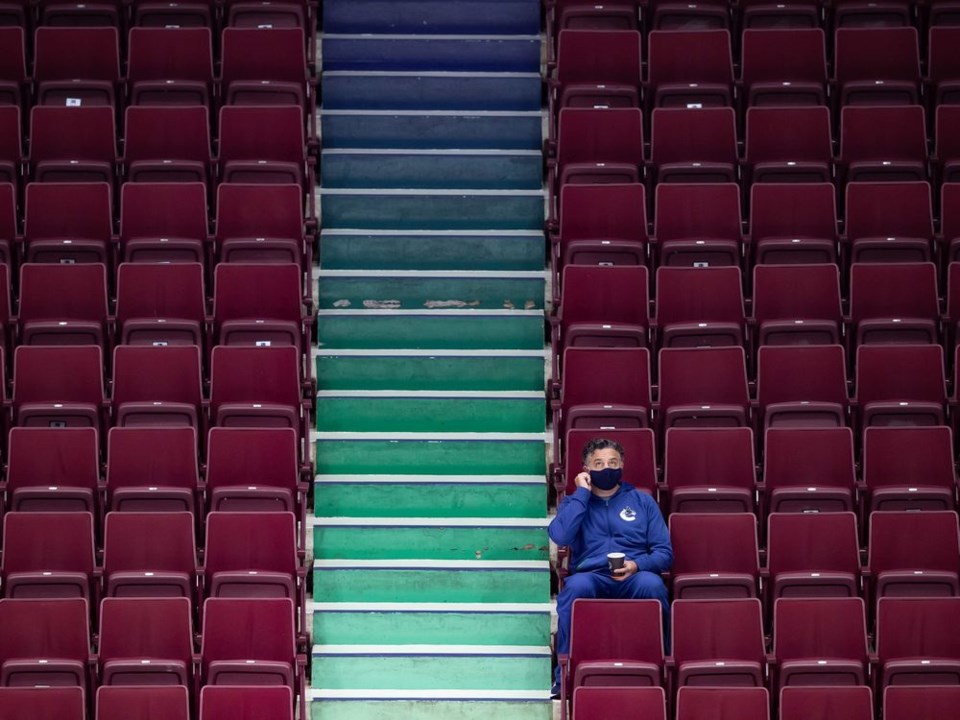The NHL season is humming along in the all-Canadian North Division. The only player on the NHL’s COVID-19 protocol list from a Canadian team is Pierre-Luc Dubois, who is undergoing quarantine after his trade from the Columbus Blue Jackets to the Winnipeg Jets.
Things aren’t going so smoothly south of the border.
Not including Dubois, there are currently 40 players on the NHL’s COVID-19 protocol list. Not all of those players will have tested positive for the virus. As fans in Vancouver saw with J.T. Miller, players considered “high-risk close contacts” of positive cases must also self-isolate.
Multiple teams have now had to postpone games due to COVID-19 outbreaks. The Dallas Stars, Carolina Hurricanes, and Vegas Golden Knights all had to postpone games earlier in the season, while the Buffalo Sabres, New Jersey Devils, Colorado Avalanche, and Minnesota Wild are in the midst of their postponed schedule.
Those latter four teams are concerning, because they seem to show that the NHL’s COVID-19 protocol failed to prevent team-to-team transmission.
"Buffalo is furious."
The Sabres and Devils played a weekend series against each other before both teams had games postponed. Similarly, the Avalanche and Wild had just played three games against each other before they each had their schedule postponed and players went on the COVID-19 protocol list.
While there’s no definitive proof, signs point to in-game transmission of COVID-19 from one team to another. What’s truly troubling is that the NHL seemed to ignore warning signs that could have prevented an outbreak for the Sabres.
The timeline is simple:
- Friday: The Devils’ Travis Zajac went on the COVID-19 protocol list.
- Saturday: The Devils, with Kyle Palmieri in the lineup, play the Sabres.
- Sunday: Palmieri goes on the COVID-19 protocol list, but the game between the Devils and Sabres goes on as planned.
- Monday: Four more Devils who played on both Saturday and Sunday go on the COVID-19 protocol list.
Soon after, a dozen more Devils players were added to the list and the Sabres were experiencing their own outbreak.
“Buffalo is furious with the league and with New Jersey,” said a source to John Vogl of The Athletic.
According to Vogl, the Sabres reached out to the NHL prior to Sunday’s game, but their request for more information was denied and the game went on as scheduled.
And yet, NHL Deputy Commissioner John Daly told Vogl, “We have seen no definitive evidence of cross-team transmission.”
Even without definitive evidence, the NHL can’t operate under the assumption that cross-team transmission hasn’t happened and won’t happen in the future.
Study shows in-game transmission of COVID-19
A study in Infectious Diseases, a peer-reviewed journal that publishes articles on human infection, found that a single asymptomatic carrier in the Finnish U-20 league led to the infection of 49 players across five teams. Not only did this one asymptomatic carrier infect his own teammates, but the study describes in-game transmission of the virus to opposing teams.
“In ice-hockey the players have many close contacts during a game, and heavy breathing due to high intensity in games,” reads the study. “One possible risk factor is the cold and dry air in ice hockey rinks, which may increase the distance of aerosol transmission.”
Consider the simple scientific fact that hot air rises. The corollary is that cold air doesn’t, and small droplets and particles that might otherwise rise with hot air instead linger and are more readily breathed in.
As a result, the cavernous confines of an NHL hockey rink don’t provide as much airflow on the ice as one might expect.
That likely explains the NHL’s unexpected move of removing the glass behind the benches to increase airflow in the area players spend the most time in close proximity. The change to the NHL’s COVID-19 protocol also included efforts to increase social distancing off the ice.
Will it work? It feels a little like putting a flea collar on the tiger that is currently eating your legs: you might not get infested with fleas, but it’s not going to do anything about the tiger.
"We are mindful of the fact that we might be seeing a more aggressive transmission of the virus and will continue to make adjustments to our protocols as we consult on a daily basis with, and adhere to, the recommendations of our medical advisors,” said NHL commissioner Gary Bettman in a statement.
Consequences beyond postponed games
While NHL players are at a lower risk from COVID-19 than some segments of the population, the virus still presents a danger and could have long-term complications.
Minnesota Wild prospect Marco Rossi, for instance, tested positive for COVID-19 while playing in Austria. He played in the World Junior Championship afterwards and was reportedly “exhausted,” but the real concerns began when he wasn’t cleared for the Wild’s training camp by doctors after his physical.
Rossi is not expected to return this season due to complications from COVID-19, though the Wild report that he’s expected to make a full recovery. What exactly has been ailing Rossi has been kept intentionally vague by the team due to medical privacy concerns.
There’s also the issue that not only the players are at risk. Coaches and staff are also frequently in contact with the players and may not be as young and low-risk as the players themselves. Sabres head coach Ralph Krueger, who is 61, was part of the outbreak in Buffalo.
Still, the NHL season soldiers on. The league is intent on carrying out the 2020-21 season to its completion. They just have to hope that the consequences don’t go further than postponed games.




